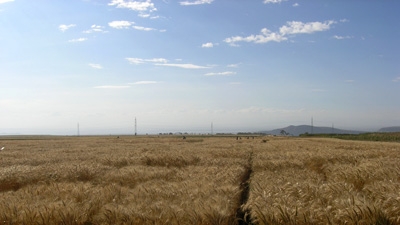ADDIS ABABA, January 23, 2013—The lush wheat land that stretches from the rural township of Kulumsa (Assela) deep into the southeastern part of the country comprises what is dubbed the Arsi/Bale wheat belt of Ethiopia. The sea of wheat farms along the belt are dotted with barley and teff fields and stretch as far as the eyes can see.
Over the years, the region gave the best wheat yield in the country, although overall production levels were not always the same. Just few years ago, the wheat lands of Arsi/Bale were dominated by smallholder subsistence farmers cropping on fragmented farm land. Wheat, in spite of its unique suitableness to the area, was planted alongside other crops. Today, through two agricultural programs supported by the World Bank, things are changing.
A monotonous wheat farmland now defines almost the entire belt. Signs of farm technologies and mechanization are visible, as well as a hint of commercialization across the Arsi/Bale wheat lands. The yield per hectare according to agricultural workers in the region has tripled in the past three years. In fact, in some places like Sinana woreda, also inside the belt, the yield has shot from around 1.8 to 5.0 tons per hectare.
The East Africa Agricultural Productivity Program (EAAPP) and Agricultural Growth Program (AGP) work together to revolutionize the core of wheat production in the region and the country. Although currently working toward a similar end, the two programs are entirely different in their design.
The AGP is a national program implemented entirely in Ethiopia, with the objective of increasing agricultural productivity and market access for key crop and livestock products in targeted woredas (districts) with increased participation of women and youth.
Convergence of the two programs appears to be ideal for the wheat surplus region. Both programs are playing key roles in improving productivity and increasing access to markets, which is the main focus of the Ethiopian government’s agricultural policy. With the aim of bringing about much needed commercialization in the sector, AGP focuses mainly on farmer capacity building and investment on small scale rural infrastructure such as irrigation schemes, rural roads and market centers. With over $330 million allocated by several development partners including the International Development Association (IDA), the AGP is currently implemented in 96 woredas in Ethiopia.
According to Teklu Tesfaye, World Bank Senior Agricultural Specialist and AGP donor coordinator, over the past two and a half years, in the woredas where the program is implemented, farmer training centers (FTCs) have become operational, and small scale irrigation schemes have been built/upgraded.
Although encouraging progress continues throughout the region and woredas, Teklu stressed the urgent need to focus on market infrastructure. “One cannot boost productivity without access to markets,” he said. “Market infrastructure is a cornerstone to commercialization of agriculture.”
AGP's approach to focus on specific woredas which are believed to have the potential for surplus production is an important departure from the traditional donor intervention in food insecure areas; which has largely ignored the growth potential of surplus producing areas. In this sense, the intervention in Arsi/Bale wheat belt could indeed be considered as a revolutionary approach.
A Regional Approach
The EAAPP is a regional program that encompasses four Eastern Africa countries; Ethiopia, Kenya, Uganda and Tanzania. Funded by $30 million from IDA, the EAAPP is fundamentally initiated to promote cooperation and investment in agricultural research and technology across the four countries. Four different agricultural commodities were selected from each country; rice from Tanzania, cassava from Uganda, wheat from Ethiopia and dairy products from Kenya. Each country was then assigned to lead the research regarding and establishment of centers of excellence for the commodities.
“The country that has comparative advantage in research and production of one of the commodities out of the four, will lead the research activity,” said Assaye Legesse, team lead for the project. “But all four countries will be doing research in all the commodities and the outcome will be shared.”
The wheat center of excellence (WCoE) in Ethiopia is spearheaded by the Ethiopian Institute of Agricultural Research (EIAR) where the Kulumsa Agricultural Research Center houses the main WCoE.
Ato Yonas, a model dairy farmer showcased by the DebreZeit research center, shared how he benefited from a research led by a CoE in Kenya. Yonas reportedly procured an improved breed of ox from the research center a year and half ago, he attests that the improved breed have been a good source of income as its reproductive qualities are in great demand in his village.
Ugandan-led cassava research outcomes are also gaining traction in the Ethiopian market. According to Assaye, since its introduction in the Ethiopian market, cassava is increasingly gaining popularity with an estimated 10,000 tones consumed annually in Addis Ababa alone. Among other things, cassava is now being mixed with teff to make Injera the traditional Ethiopian bread.
Dr. Alemayehu Assefa, EAAPP Research Coordinator at Ethiopian Institute of Agricultural Research (EIAR), says that usual threats to wheat crop such as diseases and pests are the main subjects of the center's research. But, he says that these problems are not unique to Ethiopia; they are shared by many including the three participating countries in the project. The Ethiopian WCoE is also sharing its expertise with the other countries in producing varieties of wheat which are able to withstand ecological and environmental challenges.

